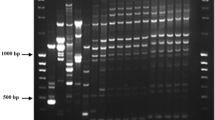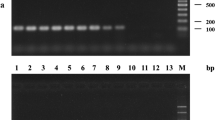Abstract
Based on the ITS regions of the ribosomal DNA, specific primer sets were developed for the citrus pathogen Guignardia citricarpa and the common citrus endophyte, G. mangiferae, and tested for their specificity against 37 isolates of G. citricarpa, 29 isolates of G. mangiferae, 10 isolates of related species and other fungi found on citrus. The efficacy of the PCR-detection method for G. citricarpa was approximately 60–70% for lesions without pycnidia, and approximately 90% for lesions with pycnidia. A reliability of 99% can be reached by analysing multiple lesions per sample. An internal control was developed to monitor DNA samples for PCR inhibition; samples with PCR inhibition should be re-examined. Detection by PCR is more rapid than the current five-day incubation method prescribed by the European Union for diagnosis of black spot lesions lacking the diagnostic pycnidia. The latter method had an efficacy of 40–50%, while culturing of suspected lesions had an efficacy of 10%. Species-specific primers and ITS sequence data showed that G. citricarpa can occur as a symptomless endophyte in leaves. This shows that wild and cultivated plants occurring in citrus groves are potential carriers of this quarantine fungus. Application of the presently developed PCR method for the detection of G. citricarpa will enable citrus producing as well as importing countries to prevent further spread of this harmful organism.
Similar content being viewed by others
References
Baayen RP, Bonants PJM, Verkley G, Carroll GC, van der Aa HA, de Weerdt M, van Brouwershaven IR, Schutte GC, Maccheroni W, Glienke de Blanco C and Azevedo JL (2002) Nonpathogenic isolates of the citrus black spot fungus, Guignardia citricarpa, identified as a cosmopolitan endophyte of woody plants, Guignardia mangiferae (Phyllosticta capitalensis). Phytopathology 92: 464-477
Böhm J, Hahn A, Schubert R, Bahnweg G, Adler N, Nechwatal J, Oehlmann R and Oßwald W (1999) Real-time quantitative PCR: DNA determination in isolated spores of the mycorrhizal fungus Glomus mossae and monitoring of Phytophthora infestans and Phytophthora citricola in their respective host plants. Journal of Phytopathology 147: 409-416
Bonants P, Hagenaar-de Weerdt M, van Gent-Pelzer M, Lacourt I, Cooke D and Duncan J (1997) Detection and identification of Phytophthora fragariae Hickman by the polymerase chain reaction. European Journal of Plant Pathology 103: 345-355
Brodrick HT and Rabie CJ (1970) Light and temperature effects on symptom development and sporulation of Guignardia citricarpa Kiely, on Citrus sinensis (Linn.) Osbeck. Phytophylactica 2: 157-164
Brown AE, Sreenivasaprasad S and Timmer LW (1996) Molecular characterization of slow-growing orange and key lime anthracnose strains of Colletotrichum from citrus as C. acutatum. Phytopathology 86: 523-527
Chiu RJ (1955) Studies on black spot of citrus. Journal of Agriculture and Forestry 9: 1-18
Courtney BC, Smith MM and Henchal EA (1999) Development of internal controls for probe-based nucleic acid diagnostic assays. Analytical Biochemistry 270: 249-256
De Boer SH, Ward LJ, Li X and Chittaranjan S (1995) Attenuation of PCR inhibition in the presence of plant compounds by addition of BLOTTO. Nucleic Acids Research 23: 2567-2568
European Union (2000) Directive 2000/29. Official Journal of the European Communities L129: 1-112
Gams W, Hoekstra ES and Aptroot A (1988) CBS Course of Mycology, 4th edn, Centraalbureau voor Schimmelcultures, Baarn/Delft, the Netherlands
Holliday P (1980) Fungus Diseases of Tropical Crops. Cambridge University Press, Cambridge, UK
International Plant Protection Convention (1999) International standards for phytosanitary measures no. 5: Glossary of phytosanitary terms. FAO, Rome, Italy
Jobes DV, Hurley DL and Thien LB (1995) Plant DNA isolation: A method to efficiently remove polyphenolics, polysaccherides, and RNA. Taxon 44: 379-386
Kiely TB (1948) Preliminary studies of Guignardia citricarpa n. sp. the ascigerous state of Phoma citricarpa McAlp. and its relation to black spot of citrus. Proceedings of the Linnaean Society of New South Wales 73: 249-292
Kotzé JM (2000) Black spot. In: Timmer LW, Garnsey SM and Graham JH (eds) Compendium of Citrus Diseases, 2nd edn (pp 23-25) APS Press, St. Paul, Minnesota, USA
Lacourt I, Bonants PJM, van Gent-Pelzer MP, Cooke DEL, Hagenaar-de Weerdt M, Surplus L and Duncan JM (1997) The use of nested primers in the polymerase chain reaction for the detection of Phytophthora fragariae and P. cactorum in strawberry. Proceedings of the Third International Strawberry Symposium, Veldhoven, The Netherlands, 29 April-4 May 1996. Acta Horticulturae 439 (II): 829-838
McOnie KC (1964) The latent occurrence in citrus and other hosts of a Guignardia easily confused with G. citricarpa, the black spot pathogen. Phytopathology 54: 40-43
Niepold F and Schober-Butin B (1997) Application of the one-tube PCR technique in combination with a fast DNA extraction procedure for detecting Phytophthora infestans in infected potato tubers. Microbiological Research 152: 345-351
Ristaino JB, Madritch M, Trout CL and Parra G (1998) PCR amplification of ribosomal DNA for species identification in the plant pathogen genus Phytophthora. Applied and Environmental Microbiology 64: 948-954
Schubert R, Bahnweg G, Nechwatal J, Jung T, Cooke DEL, Duncan JM, Müller-Starck G, Langebartels C, Sandermann H and Oßwald W (1999) Detection and quantification of Phytophthora species which are associated with root-rot diseases in European deciduous forests by species-specific polymerase chain reaction. European Journal of Forest Pathology 29: 169-187
Schüepp H (1961) Untersuchungen über Guignardia citricarpa Kiely, den Erreger der Schwarzfleckenkrankheit auf Citrus. Phytopathologische Zeitschrift 40: 258-271
Smith IM, McNamara DG, Scott PR, Holderness M and Burger B (1997) Quarantine pests for Europe, 2nd edn, Data sheets on quarantine pests for the European Union and for the European and Mediterranean Plant Protection Organization. CAB International, Wallingford, UK
Snowdon AL (1990) A colour atlas of post-harvest diseases and disorders of fruits and vegetables. General Introduction and Fruits, Vol 1, Wolfe Scientific Ltd., London, UK
Sutton BC and Waterston JM (1966) Guignardia citricarpa. CMI descriptions of plant pathogenic fungi and bacteria. No. 85. CAB International, Wallingford, UK
Timmer LW, Brown GE and Zitko SE (1998) The role of Colletotrichum spp. in postharvest anthracnose of citrus and survival of C. acutatum on fruit. Plant Disease 82: 415-418
Van der Aa HA (1973) Studies in Phyllosticta. Studies in Mycology 5: 1-110
Author information
Authors and Affiliations
Rights and permissions
About this article
Cite this article
Bonants, P.J., Carroll, G.C., de Weerdt, M. et al. Development and Validation of a Fast PCR-Based Detection Method for Pathogenic Isolates of the Citrus Black Spot Fungus, Guignardia citricarpa . European Journal of Plant Pathology 109, 503–513 (2003). https://doi.org/10.1023/A:1024219629669
Issue Date:
DOI: https://doi.org/10.1023/A:1024219629669




